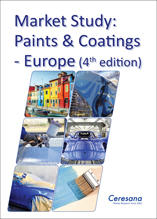Paints and coatings are not only useful for decoration, they can also provide protection. Hospital walls, for example, are increasingly often given antibacterial properties. Extremely thin but very durable coatings protect vehicles against rust. Ceresana has analyzed the entire European market for paints and coatings for the fourth time: 9.1 million tonnes of paints and coatings were utilized in 2019.
Colorful houses and cars
Architectural coatings are the most important application area for paints and coatings. Facade and interior paints are needed for residential construction and coatings are used in large commercial or infrastructure projects. Ceresana predicts that in 2027, around 58% of all paints and coatings will be used in the construction industry. Their usage for industry products, the second largest sales market, is heavily influenced by the economic situation of the respective country. Ceresana expects average growth of approx. 1.2% per year in the European demand for paints and coatings in this area.
Water-based paints preserve the environment
In addition to the division between the individual application areas, this market study also examines demand per product type: from paints and coatings on the basis of acrylics, vinyl, alkyd, epoxy, PUR (polyurethane), and polyester to products made of other base materials. With roughly 53%, paints and coatings on the basis of acrylics and vinyl currently account for the largest share of the European market. The increased focus on sustainability and the protection of the environment is, however, raising interest in water-based paints and coatings as well as other environmentally friendly alternatives. Water-based paints and coatings currently account for about 58% of the entire European market.
The study in brief:
Chapter 1 provides a comprehensive account and analysis of the European market for paints and coatings – including forecasts until 2027. It features the development of demand, revenues, as well as production. The different application areas of paints and coatings are examined separately: construction, industry products, transportation, wood processing, and other applications. Demand is additionally split by product types: vinyl, acrylics, alkyd, epoxy, PUR, polyester, other polymers, and other paints and coatings.
Chapter 2 analyses 21 individual European sales markets, such as most EU member states as well as, for example, the United Kingdom, Russia, and Switzerland.
Demand, revenues, trade, and production are described for each individual country. Demand is additionally split by product types as well as technologies for the eight largest countries.
Chapter 3 provides useful company profiles of the most important manufacturers of paints and coatings, clearly arranged according to contact information, revenues, profits, product range, production sites, and profile summary. Comprehensive profiles of 94 manufacturers are provided.
Further information: www.ceresana.com/en/market-studies/industry/paints-coatings-europe/






